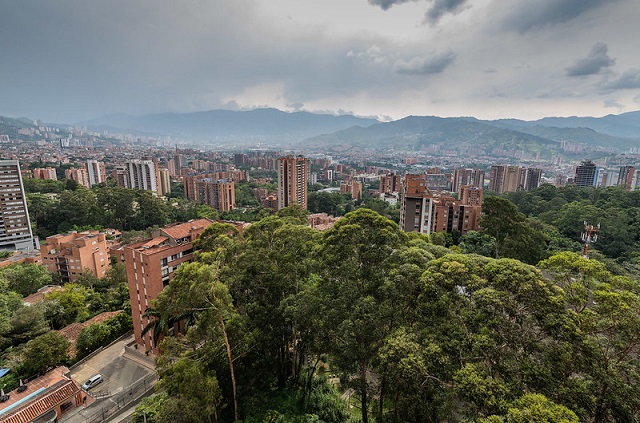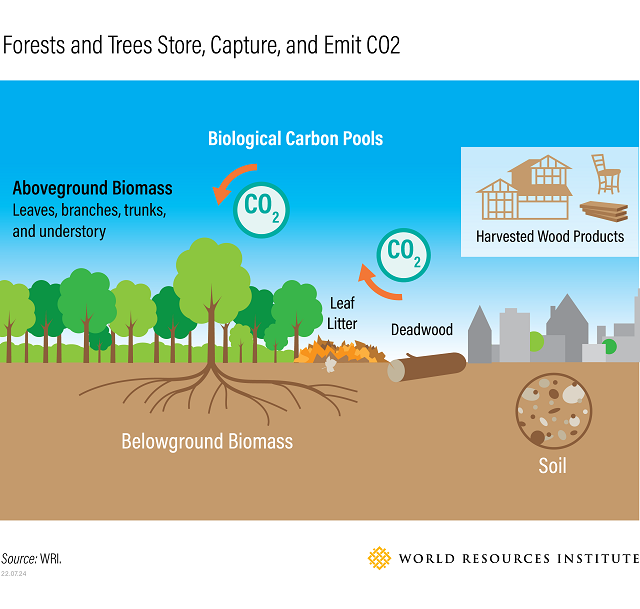
Responsible for more than 70% of the world’s greenhouse gas (GHG) emissions, action by cities is clearly crucial to limiting global warming to 1.5 degrees Celsius. An important part of this effort is developing local GHG inventories and climate action plans. These include emissions estimates from transportation, energy, housing, waste and other sectors, along with strategies to reduce those emissions and capture additional carbon through sequestration. But often missing from these is the contribution of forests and trees.
Trees have historically not been included in local GHG inventories and climate action plans due to lack of guidance about how to quantify their carbon impacts, as well as the perception that their emissions are small compared to other sectors. But as trees both emit carbon when cleared and remove carbon from the atmosphere as they grow, including these emissions and removals (sequestration) makes inventories more complete. And with urban trees in decline across the planet, quantifying this value of forests and trees can give communities yet another reason to protect them and even expand their cover.
New guidance developed by WRI, ICLEI – Local Governments for Sustainability, and C40 Cities seeks to help cities and other communities quantify GHG flows to and from forests and trees. The guidance builds on the GHG Protocol’s Global Protocol for Community-Scale Greenhouse Gas Inventories (GPC), the standard for cities conducting inventories of emissions and removals from various sectors.
Following an approach piloted in Jakarta, Mexico City, Mumbai and Salvador, this new guidance is an important advancement because it walks cities and other communities through the process of calculating annual emissions and removals from forests and trees.
For an overview of how important this process is for cities, read our introduction on Insights. Below we provide a technical walkthrough of what this guidance includes and how communities can use it.

What Is and Isn’t in This Guidance
This supplement expands on the “land” sub-sector of the Agriculture, Forestry and Other Land Uses (AFOLU) chapter of the GPC with specific guidance on calculating emissions and removals for forests and trees. It does not include guidance on land-use changes that do not involve forests, like when grasslands are converted to settlements. It does include guidance on emissions and removals for biomass in trees outside forests, like street trees and wind breaks, but not other aspects of non-forest land, like changes in soil carbon outside forests.
Communities can use this supplement to help with estimating emissions and removals within their boundaries, known as Scope 1 emissions and removals. It does not include methods for estimating emissions from sourcing areas or supply chains for resources consumed by communities, known as Scope 3 emissions. Scope 3 emissions from forests will be covered by the forthcoming Cities4Forests Forest Footprint for Cities Tool. The supplement is also not designed to help communities calculate carbon credits.
In terms of resources, the supplement includes equations and guidelines that can be applied by communities in a variety of contexts. It does not include an inventory tool or calculator, although there is a downloadable worked example spreadsheet that illustrates a full sample forest and tree GHG inventory.
Finally, this supplement provides methods for inventorying what has happened in the past and does not provide information on mitigation options or future scenarios. However, the resulting GHG inventory can – and should – be used to inform mitigation actions.
When and How Communities Should Use This Guidance
Including GHG emissions and removals by forests and trees makes GHG inventories more complete and helps quantify the importance of forests and trees for climate change mitigation, beyond their other well-documented benefits, like local cooling, stormwater management and improved human health. The goal of this supplemental guidance is to give city and community leaders tested methods to do so. By elaborating on the GPC, which is based on the IPCC Guidelines for National Greenhouse Gas Inventories, this guidance introduces globally standardized methods.
To orient first-time users, the guidance provides background on carbon emissions and removals by forests and trees and on measuring land-use change. Like for other sectors, conducting a GHG inventory for forests and trees will be most difficult the first time. To help communities that are just getting started, the guidance explains what kinds of data are needed, general data sources and key equations.
Once communities have completed their first inventory, they should publicly report the results alongside other sectors. Including emissions and removals by forests and trees can generate opportunities to revise existing mitigation targets or set new ones. The supplement addresses how to report inventory results and use them in setting climate mitigation goals.
How Communities Can Use their Forest GHG Inventory
A GHG inventory for forests and trees is not an end unto itself. Communities should use their first inventory of emissions and removals by forests and trees to establish a baseline to measure changes against. As with other sectors, this can be updated through time, enabling communities to track progress or regression, and combine with other sectoral inventories to create a more complete understanding of emissions and removals.
Communities can also track the mitigation impacts of specific activities or interventions, depending on how they design their inventory. Based on the baseline inventory and follow-up inventories, communities may find a variety of land use, vegetation management, and other policies can support non-climate goals, such as equity or health, and include forests and trees in their climate action plans.
Forests and trees are underappreciated contributors to many communities’ GHG inventories, while also having untapped climate change mitigation potential. This GPC supplement can be a key tool to help communities prepare GHG inventories that make use of that potential.
David Gibbs is a GIS Research Associate for Global Forest Watch at World Resources Institute.
John-Rob Pool is the Implementation Manager for Cities4Forests at World Resources Institute.
Nancy Harris is the Research Director for Global Forest Watch and Land & Carbon Lab at World Resources Institute.





